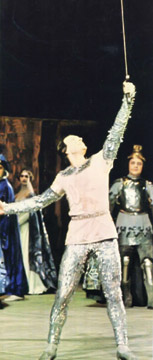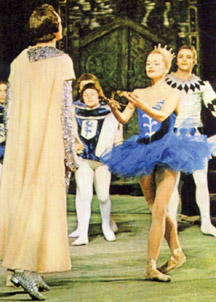The enigmatic Raymonda
There has never been a ballet as endearing as Raymonda. She is
celebrated around the world by all leading ballet companies. Romantic
settings for the nineteenth century ballets made some attempts at
historical accuracy and Raymonda is one of them. Dotted with Knights and
Saracense and court ladies and dressed in costumes that resemble the
type of clothes at the time of the Crusades. But tradition and
requirements of the classical techniques, require the ballerina to wear
pointed shoes and in the 'pas de deux' to wear the traditional tutu and
her knight change to ballet slippers and silk tights.
It is a fairy tale any way;
|

Vladilen Semenov as Jean de Brienne is proclaimed victor in
a single combat at the command of King Andrew II of Hungary
in a scene from the ballet Raymonda. |
Danced to glorious music of the Russian composer, Glozounov, Raymonda
is a romantic tale surrounding knights and Saracens set in mediaeval
Hungary. As the ballet unfurls, Raymonda is engaged to a Christian
knight called Jean de Brienne who is away at war. But at her birthday
celebrations a Saracen knight, Abderam arrives laden with rich gifts
with hopes of declaring his love for her.
He stages a lavish entertainment for her and attempts to kidnap her
but just in time, Jean de Brienne arrives and saves her from the
abduction.
The ballet concludes with yet another dazzling display that includes
Hungarian National dances that builds up to a spectacular classical 'pas
de deux'.
Raymonda's glorious classical ballet staged at the historic Kirov
Theatre in Leningrad with Irina Kolpakova in the title role when she was
a young dancer at the Kirov and married to company's leading dancer,
Vladilen Semenov who had much success in London and New York on tour
throughout the USA as well as in Russia.
Irina who is very attractive with her natural blonde hair, delicately
built and appear fragile but she has a brilliant and strong technique
she had acquired from her training at the Kirov School and from constant
daily practice since her graduation into the company.
Because it contains so much of wonderful dancing, it has managed to
survive and still an all-time favourite.
Raymonda has wondrous scores very typical Russian though the story
revolves around Hungary. French choreographer, Marius Petipa was
responsible for debuting the first version of Raymonda at St Petersburg
in 1898 and many versions of his ballet have been seen mounted in
Russia. At that time the ballet was less popular in the West partly due
to the story being overcrowded with complicated scenes, dream sequences
and especially the White Ghostly Lady which I cannot explain here. Sir
Fredrick Ashton had other ideas in mounting Raymonda with different
scores especially for the 'pas de deux' that was spectacular by all
standards, for Margot Fenteyn and Michael Somes and later for Svetlana
Beriosova and Donald Mac Leary, all for the Royal Ballet.
|

Jean de Brienne is united with Raymonda, Irena Kolpakiva in
the ballet Raymonda, mounted by the Bolshoi Ballet at St
Petersburg in this original version. |
Many modern choreographers find the ballet too much of a risk due to
the never ending change of scenes but the plucky ones take it in their
stride and come out unscathed. This is due to them being more focussed
on the dancers rather than on than its story value. Which is how a
ballet should be other than the ones on Shakespeare plays.
History of Raymonda
This ballet in 3 acts and 4 scenes was originally what Lydia Pashkova
and M Petipa who also choreographed it, brought on stage to the score of
Glazunov. It was debuted at the Maryinsky Theatre, St Petersberg in
1898. The ballet has been constantly revived in the USSR and is still
held in the repertory in the most ambitious costumes.
It saw light in the West in the production of N Zverev mounted for
the National Ballet of Lithuania, performed in London in 1935. The first
USA production was by Danilova and Balanchine who did an abbreviated
version for Ballet Russe de Monte Carlo in 1946.
A complete production was staged by Rudolf Nureyev for the touring
Royal Ballet but this was confined only to Spoleto and Baalbek
Festivals. Thereafter, Nureyev mounted the complete version for
Australia Ballet in 1965, in Zurich Opera Ballet in 1972 and for The
American Theatre Ballet in 1975. T Gsovsky made his version with the
first and second acts while Beriozoff's version with the third act for
the German Opera Ballet, Berlinin 1975.
In most of these versions the music was from blalet 'Pas de dix' in
1955 and from the Grand pas hongrois' that were Raymonda Variations in
1961 to a different set of musical scores and 'Cortge Hongrois' in 1973.
|





